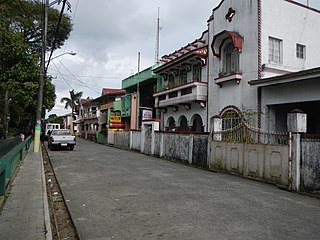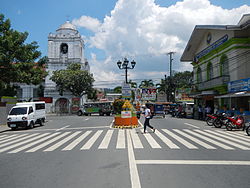
Laguna, officially the Province of Laguna, is a province in the Philippines located in the Calabarzon region in Luzon. Its capital is Santa Cruz while its largest city is the City of Calamba and the province is situated southeast of Metro Manila, south of the province of Rizal, west of Quezon, north of Batangas and east of Cavite. Laguna hugs the southern shores of Laguna de Bay, the largest lake in the country. As of the 2020 census, the province's total population is 3,382,193. It is the seventh richest province in the country in 2016.

Calabarzon, sometimes referred to as Southern Tagalog and designated as Region IV‑A, is an administrative region in the Philippines. The region comprises five provinces: Batangas, Cavite, Laguna, Quezon, and Rizal; and one highly urbanized city, Lucena. It is the most populous region in the Philippines according to the Philippine Statistics Authority (PSA), having over 16.1 million inhabitants in 2020, and is also the country's second most densely populated after the National Capital Region. It is situated southeast of Metro Manila, and is bordered by Manila Bay and South China Sea to the west, Lamon Bay and the Bicol Region to the east, Tayabas Bay and the Sibuyan Sea to the south, and Central Luzon to the north. It is home to places like Mount Makiling near Los Baños, Laguna, and Taal Volcano in Batangas.

Cavinti, officially the Municipality of Cavinti, is a 3rd class municipality in the province of Laguna, Philippines. According to the 2020 census, it has a population of 23,980 people.

Majayjay, officially designated as the Municipality of Majayjay, is a 4th-class municipality in the province of Laguna, Philippines. As of the 2020 census, the city has a population of 27,893 residents.

Liliw, officially the Municipality of Liliw, is a 4th class municipality in the province of Laguna, Philippines. According to the 2020 census, it has a population of 39,491 people.

Alaminos, officially the Municipality of Alaminos, is a 3rd class municipality in the province of Laguna, Philippines. According to the 2020 census, it has a population of 51,619 people.

Biñan, officially the City of Biñan, is a 1st class component city in the province of Laguna, Philippines. According to the 2020 census, it has a population of 407,437 people.

Calauan, officially the Municipality of Calauan, is a 2nd class municipality in the province of Laguna, Philippines. The municipality has a land area of 25.25 square miles which constitutes 3.41% of Laguna's total area. According to the 2020 census, it has a population of 87,693 people.

Famy, officially the Municipality of Famy, is a 5th class municipality in the province of Laguna, Philippines. According to the 2020 census, it has a population of 16,791 people, making it the least populated municipality in the province.

Kalayaan, officially the Municipality of Kalayaan, is a 3rd class municipality in the province of Laguna, Philippines. According to the 2020 census, it has a population of 24,755 people.

Luisiana, officially the Municipality of Luisiana, is a 4th class municipality in the province of Laguna, Philippines. According to the 2020 census, it has a population of 20,859 people.

Lumban, officially the Municipality of Lumban, is a 3rd class municipality in the province of Laguna, Philippines. According to the 2020 census, it has a population of 32,330 people.

Paete, officially the Municipality of Paete, is a 4th class municipality in the province of Laguna, Philippines. According to the 2020 census, it has a population of 24,945 people.

Pangil, officially the Municipality of Pangil, is a 4th class municipality in the province of Laguna, Philippines. According to the 2020 census, it has a population of 25,026 people.

Santa Cruz, officially the Municipality of Santa Cruz, is a 1st class municipality and capital of the province of Laguna, Philippines. According to the 2020 census, it has a population of 123,574 people.

Siniloan, officially the Municipality of Siniloan, is a 2nd class municipality in the province of Laguna, Philippines. According to the 2020 census, it has a population of 39,460 people.

General Mariano Alvarez, officially the Municipality of General Mariano Alvarez and often shortened as GMA, is a 1st class municipality in the province of Cavite, Philippines. According to the 2020 census, it has a population of 172,433 people.

Cardona, officially the Municipality of Cardona, is a 3rd class municipality in the province of Rizal, Philippines. According to the 2020 census, it has a population of 50,143 people.

Jalajala, officially the Municipality of Jalajala, is a 4th class municipality in the province of Rizal, Philippines. According to the 2020 census, it has a population of 34,017 people.

Pagsanjan Falls, also known as Cavinti Falls, is one of the most famous waterfalls in the Philippines. Located in the province of Laguna, the falls is one of the major tourist attractions of the region. The three-drop waterfall is reached by a river trip on dugout canoe, known locally as "Shooting the Rapids", originating from the municipality of Pagsanjan. The falls can also be reached from the top by a short hike from Cavinti.





























